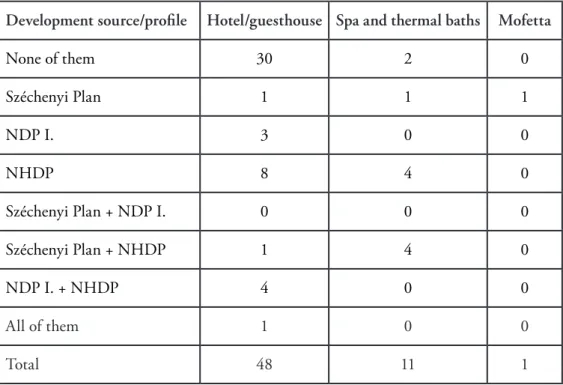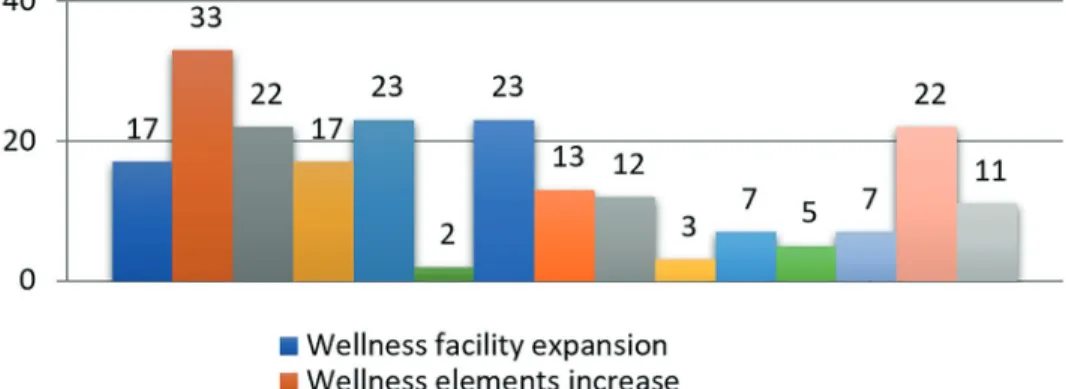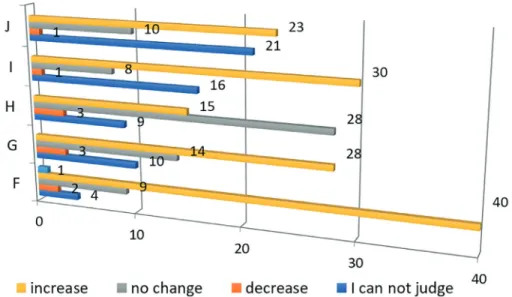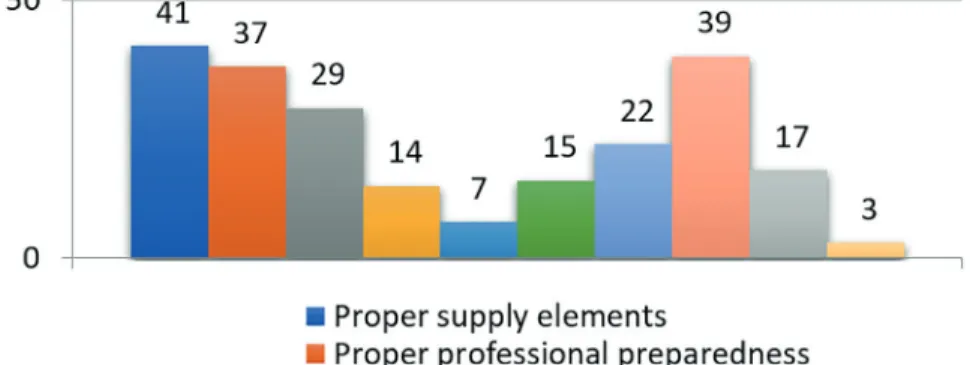SZABÓ RÓBERT
THE EFFECTS OF HEALTH TOURISM INVESTMENTS IN TOURISM BUSINESSES IN
THE NORTHERN HUNGARIAN REGION
Abstract
In my article I would like to find answers for the question how frequently and effectively the region’s business leaders in Northern Hungary participated in various development programs, as regards investments in health tourism, what developments have been made mainly in the area, what the positive effects of these developments were in the life of businesses, whether the businesses (leaders) feel successful, and how their success was manifested.
I carried out a questionnaire survey among enterprises. From the data I calculated mean, SD and spectrum and examined the crosstab correlations as well, and the Cramer’s V asso- ciate coefficient and Contingency coefficient. The results of the correlation tests could be summarised as the following:
According to the survey, the number of the medium-sized enterprises being involved utilised a significant proportion of their development funds, compared to the micro and small enterprises.
Although the idea of spas winterizing their pools was not considered an important devel- opment, both the adventure and wellness elements were important for the construction of thermal baths.
In the case of hotels, the expansion of wellness elements and other additional services together with the development of marketing activities played an important role.
Besides the positive business publicity, enterprises see the positive effects of the investment in the increase of their income; the success can be the result of the adequate supply of components, the professional management and that of positive image.
Keywords: Northern Hungarian Region, tourism enterprises, health tourism invest- ments, economic effects, development funds, success factors,
JEL code: Z32
Introduction
The most important presumed effect of the health tourism developments was to increase the touristic attraction of the given settlements (and that of Hungary), thus enhancing further touristic investments. This way of supply development can reduce the spatial and time-concentration of the international and domestic touristic demand and contributes to the enforcement of the favourable economic effects of tourism. The First Széchenyi Plan included the development of the Cave Bath in Miskolctapolca, Zsóry Bath, Thermal Bath of Egerszalók and the Eger Thermal Bath. (MUDRUCZÓ and SZENNYESSY 2005)
Tourism has become one of today’s rapidly developing sectors. Because of its multiplier effect, all countries are willing to invest in this area of development. By changing travel motivations, maintaining and preserving health comes to the forefront. There is a grow- ing demand for services towards health tourism. You can experience it in our country as well, where the spa and wellness hotels are multiplying, water parks also meet the grow- ing demand.
Our country has favorable thermal and geothermal endowments and also has long history of bathing culture, let alone a well-trained medical background; therefore it is appropriate for health tourism development.
In recognition of these values in our country, the Széchenyi Plan launched a large-scale development of health tourism, which boosted the entire economy. Then we entered the EU in 2004, thus, our country had to prepare for the 2004-2006 cycle with the NFT (NDP-National Development Plan), so we were able to secure funds for the different developments from the Structural Funds. The ROP (Reginal Operative Programme) aims at the development of tourism, continued development of reception conditions of health tourism, product diversity and human resource development. The NFT II. (NDP II.), which was made for the 2007-2013 cycle, also aims at the development of health tourism. (MÜLLER and KÖNYVES 2007)
Within the framework of the ÚMFT (New Hungary Development Plan), in the Northern Hungarian Region developing tourism was also important, besides industrial developments and extending services. (Új Magyarország Fejlesztési Terv 2007) (http://
www.nfu.hu/uj_magyarorszag_fejlesztesi_terv)
According to the ‘Healing in Hungary-Health Industry’ project of the New Széchenyi Plan, the development of health tourism in the future should be done by harmonising both touristic and health expectations. Strengthening the significance of health preserving services is inevitable, yet the background is provided by the treatments based on tradi- tional balneotherapy. It is also necessary to create the individual image of the baths and
its apparent market communication as well. Supply must not only be extended but also specialised. (Új Széchenyi Terv, Gyógyító Magyarország – egészségipari program 2011) (http://ujszechenyiterv.gov.hu/download/7/11/00000/001_Egeszsegipar.pdf)
There are many regions, small rural areas and settlements for which the development of health tourism can mean a break-out point, as it generates significant revenues, creates jobs and boosts for other areas of the economy (transportation, food, commerce).
However, it should be mentioned that there are companies having grown up billions in income (for example the spa world) and you might think that, through our traditions and medicinal waters we belong to the forefront. In fact, based on industry revenues, we belong only to the mid-range, but in new trends, in exports practically we do not take part. The reason for this is partly the significant shortcomings of domestic entrepreneur- ial culture and entrepreneurial knowledge in the industry. (VÁRHELYI 2009)
It can be heard about cases when more than half of the owners of Hungarian hotels and pensions would like to get rid of their establishments, in spite of the fact that several tens of billion forints have been spent on building new ones. The money of those being in the worst situation has already been by the bank. (GALAMBOS 2013)
The impact on the lives of the economic impact of health tourism investments, busi- nesses and municipalities have been examined in other previous studies, such as:
Dr. Mundruczó Györgyné – Dr. Szennyessy Judit (2005): Economic impact of health tourism developments in Hungary
Dr. Mundruczó Györgyné – Dr. Pulay Gyula – Tököli László (2010): Examination of state support for regional tourism development and efficiency of national economy
Péter Zsolt (2010): The processes of regional tourism context in particular the North- ern Hungarian Region
Molnár Csilla (2011): The effects of health tourism development, especially in East-Hungary
Molnár Csilla – Kincses Áron – Tóth Géza (2009): The effects of spa development in Eastern Hungary, comparing Hajdúszoboszló, Eger and Orosháza
Materials and Methods
I wanted to present these research companies involved in health tourism in the region of Northern Hungary in terms of their relationship and experience concerning health tourism invesmtents.The companies can be divided into two large groups according to their profiles.
Firstly, the spa and bath type businesses (I also include the mofetta of Mátraderecske here), and the type of commercial accommodation (hotels and guesthouses).
The scope of the surveyed hotels was definitely the spa and wellness hotels, but consid- ering the fact that wellness is an important element in the service for castle hotels and most hotels of different profile (e.g. urban hotels, conference hotels observed) also supply elements for wellness (to have a more colourful supply), other profiles of hotels and gusethouses have been included within the scope of those surveyed.
Businesses in the sample were selected based on an address list compiled by me in order to fill in the questionnaire.
In the case of thermal baths, plage and swimming pools their health tourism linkage was not a question, but in the case of hotels and motels I could gain knowledge on the basis of their websites, whether they provide some kinds of health tourism services (espe- cially wellness), and the address list was compiled based on this information.
In the case of spa and wellness hotels the connection to health tourism is evident, but as their number is not very high in the region, other types of hotels have been sampled into account, where they also have spa services. The questionnaires have been sent out to about 110 tourism businesses based on the search of the Internet address list. The ques- tionnaire was voluntary, and businesses in the region were reached by e-mail and then I asked the business representatives, senior employees by telephone consultation to kindly help us by filling in the questionnaire research. In many cases, only the fifth or sixth visit by telephone and e-mail led to results.
It was important that the questionnaire should be filled in by the head of the company, or by a specific manager or subordinate.
The spas, thermal baths and swimming pools (and mofetta) sent back 12 pieces, the hotels and guesthouses sent back 48 pieces of questionnaires that counted valid.
This represents more than a 50% return rate, which can be said really good in the case of a ‘traditional’ research. The questionnaire contained mostly closed questions that have multiple answers in the available categories. The questionnaires were processed in the PASW Statistics software.
From the data I calculated mean, SD (standard deviation), spectrum and examined the crosstab correlations as well. The intensity of the correlations between criteria is examined with the help of Cramer’s V associate coefficient and Contingency coefficient.
It means to examine to what extent a correlation is close to independence or a func- tion-like connection. Cramer V can be applied with any cross tables and according to many researchers it is the most reliable index. (SAJTOS and MITEV 2007) This is the reason for my choice as well.
Cramer associate co-efficient can be between 0 and 1. In the case of 0 there is no connection between the two criteria (they are independent), whilst when it is 1, there is a function-like correlation between them. The intermediate state can rest on the strength
of the weak link (from more than 0 to 0,3), medium (ranging between 0,3 and 0,7), or strong (from 0,7 to below 1). (KORPÁS 1997)
The Results of the Questionnaire Survey Aims, Main Hypotheses
I intend to present with this research the main features of the health tourism business enterprises in the Northern Hungarian Region (company profile, size, year of establish- ment, the use of development funds).
It has been assessed how frequently and effectively participated the region’s business leaders in health tourism investments and in the various development programs, what developments have been made mainly in the area, what the positive effects of develop- ment projects were in the life of the businesses, how successful businesses feel themselves and how their success is manifested. In the case of tourism enterprises in investment, developments generally gave a positive impact on the firm, but there are also examples where the expected positive effects have been missed. A holding company itself is likely to be successful not only in domestic, but in an international competition, too.
During my study I wanted to find answers for the following questions, connections:
1. Is there a connection between the operation of the company, the date of foundation, size, profile and participation in the various funding programs and development?
2. What type of health tourism investments/developments have been implemented so far by the tourism enterprises concerned?
3. Do health tourism investments have a positive impact on business, and if so, in what form? What changes have occurred in enterprises due to the realized investment in health tourism?
4. Do business executives believe their business is successful (due to the realised health tourism investments), and how are these success factors manifested?
Business location, profile, size, year of establishment, participation in development programs
Based on the questionnaire data it can be known in which county the company oper- ates, what the main profile of the business is, the size of the enterprise (micro, small or medium-sized enterprises –the values required for the classification of domestic SMEs have also been stated, to be clear - , number of employees, annual net turnover, balance sheet total), and the year of the foundation of the company. These data will be important
factors in the context of investigations in the future. The companies were selected in the Northern Hungarian region, 48,3% of responses were received from Borsod-Abaúj- Zemplén County, 40% from Heves county, while 10,7% from Nógrád county. Looking at the sample it was representative considering the number of businesses and firms are present in a similar proportion in the three counties.
Businesses profiles were divided into three groups: hotels, guesthouse type of business (48 units), with spa and thermal bath types of businesses (11 units), and mofetta (1).
However, since it was possible to add more profiles, it can be seen that a wide variety of hotel types and an en suite types exist, as shown in Figure 1.
Figure 1: Distribution of businesses by profile
Source: Compilation by the author based on questionnaire survey
Many hotels of various categories have been (also on ancillary basis) operating for some time with spa and wellness facilities and some hotels also feature a mix profile (i.e.
wine and spa, conference and wellness). According to the companies based on the size of SMEs, micro rating is 23.3%, 50% represents the small and 26.7% of the medium-sized
enterprises of the sample. According to the established businesses 21.7% was founded before 1994, those between 1995-98, 1999-2002 and 2003-2006 are 23.3% and 8.3%
was founded in 2007-2010 founded in the sample. It was an important consideration in the selection that the given business should have at least a three -year- operating time.
I examined the company’s location, profile, size, year of establishment, and a variety of Developed programs such as the Széchenyi Plan, NDP (National Development Plan), NHDP (New Hungary Development Plan) (and various combinations of these, all three or none no electoral alternatives) with regard to the involvement observed in any kind of relationship. As an alternative choice, the New Széchenyi Plan was not included in the questionnaire since during the period of the survey these projects have not been completed fully.
The Cramer V association coefficient of distribution of the test sample profile accord- ing to the company size, location and operating profile and according to their creation of profiles showed a weak link (range 0.14 to 0.22), but the pattern for development and distribution of resources according to profiles has moderately strong correlation (Cram- er’s V: 0.575, contingency coefficient 0, 631).
Development source/profile Hotel/guesthouse Spa and thermal baths Mofetta
None of them 30 2 0
Széchenyi Plan 1 1 1
NDP I. 3 0 0
NHDP 8 4 0
Széchenyi Plan + NDP I. 0 0 0
Széchenyi Plan + NHDP 1 4 0
NDP I. + NHDP 4 0 0
All of them 1 0 0
Total 48 11 1
Table 1: The distribution of the sample according to development resources and profile (number of units)
Source: Compilation by the author based on questionnaire survey
The table shows that most hotels and guesthouses do not take part in requiring any resource development, mainly pools benefited from these opportunities. It is relatively rare that a company can take more development cycle funds (in the case of filled in questionnaires).
Sample distribution of development resources and operation by location, in the cases of the development fund and the year of foundation show weak ties (Cramer’s V: from 0.340 to 0.325), the distribution of the pattern of development resources and size, according to the case, however, shows a moderately strong correlation (Cramer’s V:
0.576, Contingency coefficient: 0, 631).
Health tourism investment and development projects implemented by tourism enterprises
For this question businesses could nominate several answer options. The marked answers had to be ranked in terms of importance, what was the most important development (e.g. 1 is the most important). I tried to compile the full range of development oppor- tunities but there are some categories clearly related only to baths or to hotels. There are a number of categories which can be related to both business profiles. Consequently, the results were predictable in advance, for example “Increasing surface water” in the first place was experienced in baths (Cramer’s V: 0,502, Contingency coefficient 0,579).
According to the survey, winterizing pools for spas was not considered an important development (maybe they have already done that earlier). However, all of the adventure and wellness elements were important for the construction of thermal baths.
In the case of hotel types of enterprises the most representative task was mainly to expand the capacity of wellness facilities and increase the number of wellness items (Cramer’s V: 0,542, Contingency coefficient: 0,609), but the expansion of the well- ness elements and their role in other ancillary services and development of (although the range of additional services was not clearly clarified for them) marketing activities (Cramer V: 0,439, Contingency coefficient: 0,527) was also important.
Regarding developments it can be mentioned that recreational sports have to be adjusted to the family structure and have to take into account the factor concern- ing age specific needs, bearing capacity and skilled-related background. Several authors highlight the importance of games, lifetime sports and nature-based sports (KÖNYVES and MÜLLER 2001, KERÉNYI et al. 2009) as they can be performed by virtually the whole family regardless of gender and age. These activities have a high potential of shaping communities and it is a beautiful sight when „several genera- tions train playfully together and grandchildren, children, parents and grandparents share the joy of doing sports.” Knowledge of fitness and recreation trends is crucial to
professionals and companies operating in the leisure sector as the adequate response to changing consumer behaviour can be the key to success. Retaining good health is one such trend and a priority not only in recreation, but in tourism as well (MÜLLER et al., 2013). There are several spas that cater for the needs of three generations. In spas where the target audience is the family, services matching the needs of several genera- tions have to be created. (KÖNYVES et al., 2005, BARTHA et al., 2011, MÜLLER and KÓRIK, 2009, MÜLLER et al., 2005)
Figure 2: Health tourism investments implemented by tourism businesses (pieces)
Source: Compilation by the author based on questionnaire survey
The impact of health tourism investments in businesses and its manifestations
In this section it has been studied if health tourism investments have a positive impact on businesses. If so, in what forms and what changes have occurred in enterprises due to realized investments in health tourism. The vast majority of the respondent firms (imple- menting health tourism investments) have reported clearly positive effects (there were some who have not). The positive effects occurred is shown in Figure 3.
Figure 3: The manifestations of health tourism investments by businesses (pieces)
Source: Compilation by the author based on questionnaire survey
The changes (increase, decrease, no change, I cannot judge) could designate the case as follows (To choose from the different levels of increase/decrease was not an option):
A Company’s (positive) awareness B Business confidence in the company C Number of business partners D Value of investments
E Seasonal fluctuations in turnover F Turnover
G Number of bed nights H Number of competitors
I Tax rate paid to local authority J Pre-tax profits
Figure 4: What changes have occurred due
to the implemented business of health tourism investment? (marked) (1.)
Source: Compilation by the author based on questionnaire survey
Figure 5: What changes have occurred in your business due to the implemented investment in health tourism? (marked) (2.)
Source: Compilation by the author based on questionnaire survey
Businesses have seen positive results primarily in the increase of “number of business partners”, “value of investments” and “number of bed nights”.
The success factors of health tourism investments implemented by companies
In this issue I examined the question if business leaders consider their firms to be success- ful (due to the realized investment in health tourism) and how these success factors are manifested. The vast majority of respondents (those implementing health tourism invest- ments) judged their business ventures as successful.
Business executives could nominate the following answers, and they also had to prioritize which factors they considered the most important for their success. The hotel businesses considered the supply elements to be the most important, as well as the appro- priate professional skills, professional management, positive image and good reputation.
Figure 6: The success factors of health tourism investments implemented by businesses (marked)
Source: Compilation by the author based on questionnaire survey
Results and Conclusion During my research the following questions were examined:
1. According to the survey, medium-sized enterprises involved in utilised a significant proportion of development resources compared to micro and small enterprises, so it seems that those companies are able to successfully acquire the resources they need for their development which operate under favourable financial circumstances.
2. It assumed that the primary consideration for spas was to winterise their pools (earlier for several baths it appeared as weakness), while for thermal baths to increase the number of adventure elements.
As for hotels, I presumed that the most important could be to increase the capacity of wellness section and the number of wellness elements.
According to the survey, winterizing pools was no longer considered an important development for spas (they may have it available beforehand).
However, all of the adventure and wellness elements were important for the construction of thermal baths.
In addition to the expansion of wellness elements, for hotels it was also important to provide ancillary services and develop marketing activities.
3. Health tourism investments have a definitely positive impact on a large part of the interviewed enterprises. In addition to their positive awareness, they see the positive effects of the investments in the positive sales growth (turnover).
4. Despite criticism it seems entrepreneurs generally consider their businesses to be successful. They see the success of their businesses primarily in the proper supply elements, professional management and positive image.
References
BARTA G. - PÁLINKÁS R - MÜLLER A. (2010): The Role of the Saliris Thermal Spa’s bath in the tourism and recreation. In: Acta Academiae Agriensis Nova Series Tom- Sectio Sport. 2011. 38: 5–13.p.
GALAMBOS P. (2013): Ész nélkül szórták a milliárdokat a vidéki wellnessekbe, 2013 http://www.origo.hu/gazdasag/20130628-valsag-a-szallodaiparban-tulkinalatot- okoztak-az-unios-penzek.html
KERÉNYI E. - MÜLLER A. - SZABÓ R. - MOSONYI A. (2009): Analysis of Agárd, Komárom and Pápa’s Thermal and Experiences Bath, according the guest’s satisfaction.
Egészségügyi marketing és telekommunikáció című konferencia kiadványkötete (CD) 1-11.o. 2009. Egészségügyi marketing és telekommunikáció. Mátrai Gyógyintézet.
Magyarország, Kékestető.
KORPÁS A. (1997): Általános statisztika I., Nemzeti Tankönyvkiadó, Budapest
KÖNYVES E. - MÜLLER A. (2007): Az Észak-alföldi régió Turizmusfejlesztési straté- giája 2007-2013. In: PTE TTK Földrajzi Intézet: Fejlesztés és képzés a turizmusban.
II: Országos Turisztikai Konferencia tudományos közleményei, Elektronikus kiadvány (CD), 2007 Pécs
KÖNYVES E. - MÜLLER A. (2001): Szabadidős programok a falusi turizmusban. 2001.
Szaktudás Kiadó Ház, Bp. 213.p.184.p.
KÖNYVES E. - MÜLLER A. - SZALAY F. - SZABÓ R. (2005): Cserkeszőlő és Karcag egészségturizmusának összehasonlító elemzése. In: Szolnoki Tudományos Közlemények IX. (cd) 2005. (Szerk.: (Szabolcsi R. – Kádár Z. – Pelikán L.) ISSN:1419-256-X.
MOLNÁR Cs. (2011): Az egészségturisztikai fejlesztések hatásai, különös tekintettel Kelet – Magyarországra, 2011
MOLNÁR Cs. - KINCSES Á. - TÓTH G. (2009): A fürdőfejlesztések hatásai Kelet- Magyarországon Hajdúszoboszló, Mezőkövesd és Orosháza összehasonlítása, 2009 MUDRUCZÓ GY. - SZENNYESSY J. (2005): Az egészségturisztikai fejlesztések gazda-
sági hatásai Magyarországon, tanulmány - I. kötet, 2005 http://www.polgariszemle.
hu/app/data/17.pdf
MUNDRUCZÓ GY. - PULAY GY. - TÖKÖLI L. (2010): A turisztikai fejlesztések állami támogatása térségi és nemzetgazdasági szintű hatékonyságának vizsgálata, 2010
MÜLLER A. - BÍRÓ M. - HIDVÉGI P. - VÁCZI P. - PLACHY J. - JUHÁSZ I. - HAJDÚ P. - SERES J. (2013): Fitnesz trendek a rekreációban. In: Acta Academiae Agriensis. XL. 2013. 25–35.p.
MÜLLER A. - KÓRIK V. (2009): Az Észak-alföldi fürdők szerepe a turizmusban és a rekre- ációban. In. Economica 2009. 2:58–72. p.
MÜLLER A. - KÖNYVES E. - SZABÓ R. (2005): A wellnessturizmus sokszínű kínálatá- nak bemutatása; In: Iskolai testnevelés és sport. 2005., 27: 29–34. p.
PÉTER ZS. (2010): A turizmus térségi folyamatainak összefüggései különös tekintettel az Észak-magyarországi régióra, 2010
SAJTOS L. - MITEV A. (2007): SPSS kutatási és adatelemzési kézikönyv, Alinea Kiadó, 2007
Új Magyarország Fejlesztési Terv 2007 (2007) http://www.nfu.hu/uj_magyarorszag_fejlesz tesi_terv
Új Széchenyi Terv, Gyógyító Magyarország – egészségipari program 2011 (2011) http://
ujszechenyiterv.gov.hu/download/7/11/00000/001_Egeszsegipar.pdf
VÁRHELYI T. (2009): Világtrendek a turizmus iparban, Szolnoki Főiskola, 2009.
Szerző Szabó Róbert Egyetemi tanársegéd Eszterházy Károly Egyetem szabo.robert@uni-eszterhazy.hu





